Author: Ray
Source: ArkStream Capital
The Environment of New Public Chains
If the blockchain world follows the law of universal gravitation, then currently, Bitcoin and Ethereum are like the two brightest stars, illuminating this dazzling galaxy. The reason they are able to shine brightly and sparkle among the stars lies in their original technology implementation (i.e., blockchain and smart contract platforms) and continuous years of iterative upgrades, resulting in their massive market value, thriving ecosystem, and active community.
In the cryptocurrency cycle from 2017 to 2021, we often heard the term "Ethereum killer." Many new public chains aimed to surpass Ethereum and proposed their own technical architectures and implementation solutions, such as Solana, which introduced Proof of History, Avalanche, which adopted the Avalanche protocol and subnet functionality, NEAR, which focused on sharding technology, Flow, which separated consensus and computation, EOS, which had parallel processing and asynchronous communication capabilities, IOTA, which had a DAG transaction structure, and Polkadot and Cosmos, which natively supported multi-chain. It must be said that they all achieved success in specific periods in terms of on-chain user daily activity, DApps development, and TVL data metrics. However, with various reasons (such as team stagnation and funding collapse) and the gradual launch of Ethereum's Rollup layer, the situation quietly changed. The most obvious change is that in the DeFiLlama public chain TVL rankings, Arbitrum and Optimism surpassed most Alt L1 chains. In addition, some innovative projects also shifted their focus to the Rollup layer network, with the most representative example being the derivative platform GMX, which migrated from Avalanche to Arbitrum.
At the current point in time, the stable development of Bitcoin and Ethereum, as well as the rapid growth of the Layer 2 network, clearly pose a squeeze on the once lively Alt-L1 market. Many Alt-L1 projects seem to be in a "stagnant" bottleneck, which does not bode well for new public chains. Take the recent Move-based new public chains Aptos and Sui as an example. The market's sentiment towards them has changed dramatically. Before the mainnet launch, there was a strong interest in deeply understanding their whitepapers and technical architectures, envisioning their application scenarios, and developers were eagerly learning new contract languages and DApps project teams were competing for various ecological positions on the new public chain. However, after the mainnet launch, especially after the token issuance, with the downturn of the DApps ecosystem and the lackluster TVL data, everything seemed to slip away from us.
PS: Considering that privacy public chains emphasize anonymity and user privacy protection, and storage public chains emphasize decentralized storage, their design concepts and technical roadmaps differ to some extent. In order to focus the discussion more deeply, we will temporarily not explore privacy public chains and storage public chains.
The Necessity of Developing New Public Chains
It can be said with certainty that developing and implementing new public chains to challenge the two giants, Bitcoin and Ethereum, and even the burgeoning Layer 2 networks, is undoubtedly a challenging endeavor. This inevitably leads us to ponder the question: Is it really necessary to continue developing new public chains?
The answer is yes. From the perspective of mass adoption, the entire Web3, from 2020 to the present, has seen the emergence of diverse new application scenarios such as DeFi, NFTs, and the Metaverse. The user adoption level has also risen to the level of millions or even tens of millions. However, compared to technologies that have already achieved mass adoption, such as search engines and instant messaging, the development space for Web3 is still enormous. If we compare the infrastructure of Web3 public chains to traditional cloud computing, the number of applications and users of public chain services is still in a rapid growth stage, far from reaching the mature stage of large-scale applications. Therefore, the size of the future market cake and the rapid changes in demand will give rise to the appearance of public chains with excellent service capabilities and response speeds. Currently, in the field of public chains, Bitcoin and Ethereum have taken the lead and gained widespread recognition and market share. However, this does not mean that other Alt-L1 and new public chains have no room for survival or opportunities to overtake in certain niche areas. It is for this reason that institutions are willing to invest a large amount of funds in the field of public chains, not simply based on financial investment considerations, but rather on their judgment of the future of Web3 and the importance of public chains.
Hard Power and Soft Power
When analyzing public chains, we can evaluate them from two aspects: hard power and soft power. Hard power mainly focuses on the technical innovations involved in public chains, such as P2P networks, consensus mechanisms, block data structures, smart contract languages and virtual machines, token economics, and the ability to adapt and adjust to the current state of technological development. Soft power involves more business operation capabilities, ecosystem construction, and capital coordination. Both of these powers are indispensable in the development and implementation of public chains. If a public chain only has hard power but lacks soft power, it is easy to fall into the dilemma of working in isolation. Conversely, if a public chain only has soft power but lacks hard power, it will not go far.
In terms of hard power, Alt-L1 chains are prone to technical rigidity and stubbornness. This is why we emphasize the ability to adapt and adjust to the current state of technological development. Shortly after the founding of Bitcoin by Satoshi Nakamoto, the entire network and community development were organic. When it came to major functional changes and support for new features, the overall progress was slow and conservative. However, it is now also keeping up with the times, such as the recent popular Ordinals protocol. Ethereum's scaling solutions were once dominated by the Plasma solution before formally transitioning to a Rollup-centric approach. In the new version roadmap announced by Ethereum last year, we can see that the focus at the protocol level is mainly on the security of the PoS consensus mechanism and decentralization optimization, the combination of data sharding and Rollup, and the original goals of eWASM and state sharding have been replaced by other features.
Exploring Innovative Technologies
When Ethereum's Frontier was launched in 2015, it provided a basic usable network, including features such as the PoW consensus mechanism, transactions, account models, and the core EVM smart contract platform. Over the years, Ethereum has continuously iterated and upgraded, such as the more stable and efficient Homestead in 2016, Metropolis Byzantium in 2017, which supported ZK-Snarks proof chain on-chain verification through precompiled contracts, the Beacon Chain supporting PoS functionality in 2020, the London Hard Fork introducing the EIP-1559 market transaction fee model in 2021, and the Paris upgrade in 2022, which officially closed PoW and initiated PoS (ETH Merge). Ethereum adheres to the spirit of open and free blockchain, beginning with rich programmability and never stopping, demonstrating a public chain's continuous development in the exploration of innovative technologies through upgrade after upgrade. 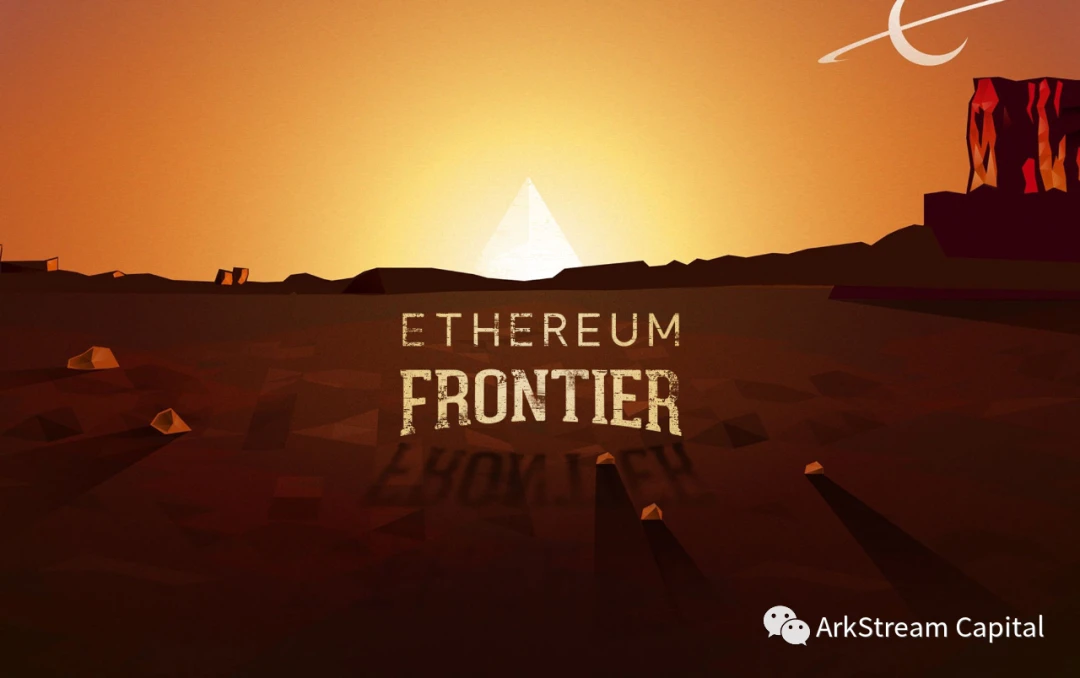
For this reason, whether it is a new public chain that has not yet been launched in the primary market or an old public chain that has been listed on the secondary market for a long time, both new and old public chains that are willing to explore innovative technologies are worth our attention and study.
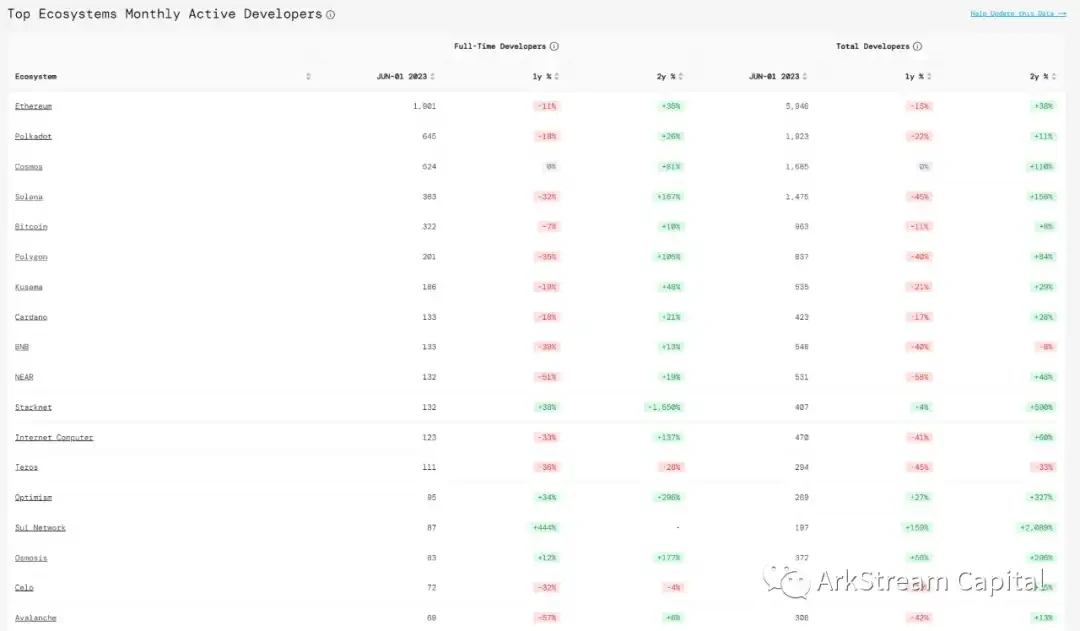
Next, let's temporarily ignore the merits of public chain economic model design and the performance of market tokens, and, in combination with the open source developer data panel provided by Electric Capital, further research some interesting public chains outside of Ethereum, focusing on their unique or iconic innovative technologies.
Polkadot - Substrate
Polkadot introduces the concept of relay chains and parachains through blockchain parallelization technology, and achieves shared security and inter-chain communication for multiple blockchains through the cross-chain communication protocol XCMP. The technology framework that supports these features of Polkadot is Substrate. Substrate provides the smallest development unit, Pallets, which abstracts various functional modules such as assets, staking, and EVM. Based on Pallets, it provides the development framework Frame and a customizable runtime for blockchains. Combined with its unique asynchronous model and parachain sharding mechanism, Substrate provides the capability to process a large number of transactions simultaneously, improving the overall network throughput and performance. In addition, Substrate also supports pluggable consensus mechanisms, allowing developers to choose different consensus algorithms as needed. Furthermore, Substrate has built-in support for the Ethereum EVM and WASM runtimes, making it convenient for applications in the Ethereum ecosystem to migrate and develop. Finally, Substrate supports on-chain hot upgrades, allowing blockchains to be upgraded and updated without interrupting the network.
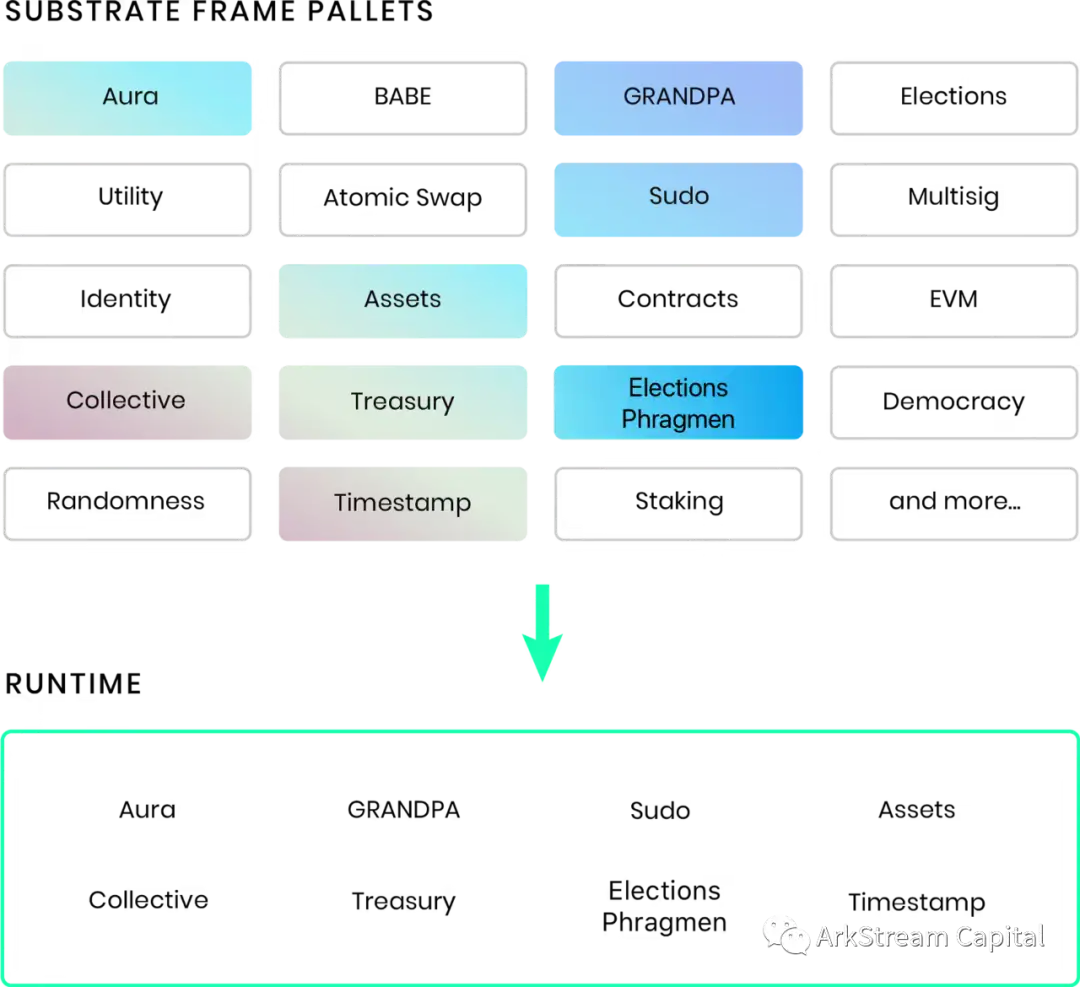
Cosmos - Tendermint / Sovereign Chain / App Chain / IBC
Tendermint was one of the first to implement the Byzantine fault-tolerant PoS consensus algorithm and was also an inspiration for Ethereum's PoS algorithm. The concepts of Sovereign Chain and App Chain perfectly embody Cosmos' decentralized multi-chain concept, allowing each sovereign chain to have its own consensus mechanism, economic model, and governance rules, as well as allowing specific applications or services to directly build small application chains through the Cosmos network. The two can communicate and interact with each other through IBC, creating an overall multi-chain Internet advocated by Cosmos.
Cosmos - Core Development Suites
Cosmos has two core development suites: CometBFT, which implements the Tendermint consensus algorithm and defines the application connection interface ABCI, and the Cosmos SDK, which supports IBC and CosmWasm. The ecosystem consists of the central Cosmos Hub and various Zones connected to the Cosmos Hub. Since the launch of the Cosmos mainnet in 2019, IBC has evolved from supporting initial Zone interconnection, Zone and Hub interconnection, to richer and more complete features such as Inter-Chain Accounts (ICA) and Inter-Chain Security (ICS). In September 2022, the Cosmos Hub will mark a key turning point, transitioning from the first stage initiation to the second stage integration.
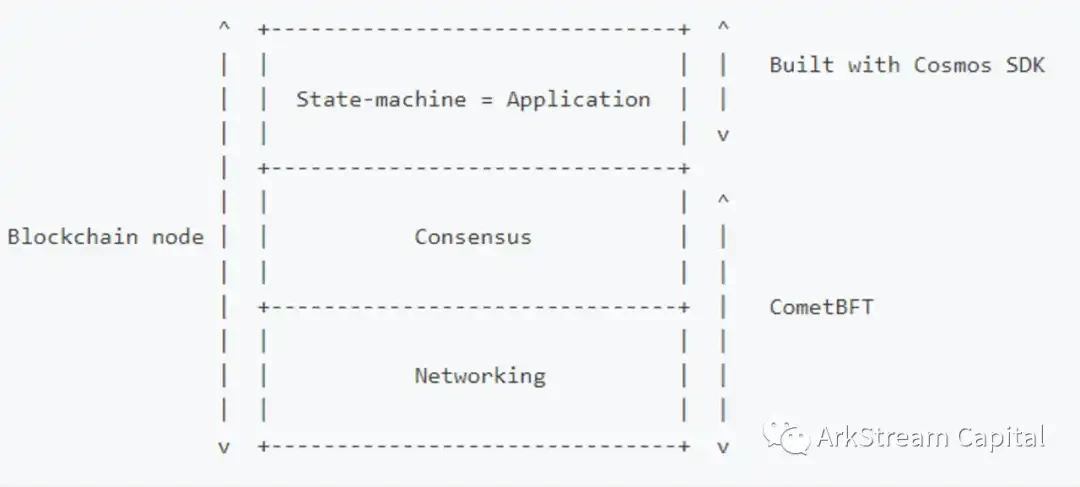
Sei Network - Optimized for Trading
As a recent popular application chain in the Cosmos ecosystem, Sei features a built-in order matching engine, sub-second settlement speed, parallel processing of orders, and single-block order execution. All these customized features are implemented at the base layer, primarily through optimizations using ABCI++. ABCI++ is an upcoming upgrade to Cosmos' ABCI, allowing each step of the consensus to be programmable.
Solana - Proof of History
Proof of History (PoH) is an innovative time-stamping technology that acts as a global clock in distributed systems, coordinating operations and time sequences among network nodes. By embedding timestamps in each block, PoH constructs a globally shared time series within the Solana network, enabling nodes to easily verify the order and time of transactions. This not only improves the network's throughput and performance but also effectively prevents malicious tampering and replay attacks.
NEAR - Nightshade Sharding / Beacon chain
Derived from the early sharding concept of Ethereum, NEAR also inherits the concept of the Beacon chain but optimizes the block producers and validators for each shard. Each shard has a group of block producers responsible for generating blocks and packaging transaction and state data. Due to the relative independence of each shard, each block producer only needs to focus on their own shard, independently generating blocks without coordinating with block producers from other shards. Validators also only need to verify transactions and states belonging to their own shard, without concerning themselves with the entire network's state. This improves the efficiency of block production and validation, allowing for more transactions and state updates to be processed.
Avalanche - Avalanche Consensus
The Avalanche protocol introduces a voting mechanism that creates a snowball effect, allowing nodes to quickly reach consensus and form a consistent decision sequence across the entire network. The key to the protocol lies in the multi-round voting and iterative decision-making process, gradually converging nodes in the network to a consistent consensus result through continuous voting and feedback. As nodes can vote and make decisions in parallel, the overall system's parallel processing capability is enhanced. The Avalanche protocol also allows for dynamic node entry and exit, as well as adaptive adjustments to voting rules and parameters, enabling flexible scalability.
Flow - Multi-Node Architecture
Flow features a pipeline-style multi-node architecture. Execution nodes are responsible for transaction execution, enabling high-volume transaction processing and computational operations. Verification nodes monitor and verify the computational results of execution nodes, ensuring the correct execution of smart contracts according to the rules and verifying the accuracy and consistency of the computations. Consensus nodes are responsible for transaction ordering and block generation, ensuring network security. This multi-node architecture, resembling the modularized blockchain's execution layer, data availability layer, settlement layer, and consensus layer, is implemented at the public chain level.
Monad - Asynchronous Concurrent Transactions
Monad is an EVM-compatible L1, and transactions are equivalent to EVM. To increase TPS, Monad identifies and labels non-interfering transactions, eliminating their common dependencies, and achieves high-concurrency transaction performance through asynchronous execution.
Diem/Libra - Move
Since its inception, Facebook/Meta's Diem (formerly Libra) has attracted attention from both inside and outside the industry. Whether facing criticism from traditional regulatory agencies or skepticism from the native Web3 world, Diem's original intention was to serve billions of people globally, allowing them to fully enjoy financial services comparable to traditional banking payment systems. To achieve this, Diem designed high-performance validation nodes and the Move language and corresponding Move virtual machine, which balances asset security and smart contract execution efficiency. However, due to regulatory and policy reasons, Diem has not been able to launch its mainnet as planned. Following this, the Diem team, after inheriting these technological accumulations, has derived three different exploratory public chain projects, namely Sui Network, Aptos, and Linera.
Sui Network - Causal Order / Object Model
Sui Network adopts a DAG-like approach for transaction processing, combined with a unique object model and a version management mechanism similar to snapshots, allowing transactions to be ordered causally rather than requiring a complete sequential arrangement. This naturally provides massive parallel execution capabilities. The underlying technological support for this is derived from Sui's optimization of the object system in the Move language, adding numerous asset attributes related to Web3.
Aptos - Block-STM
Aptos' parallel execution engine, Block-STM, directly introduces an optimistic concurrency control mechanism at the first-layer public chain, similar to the optimistic fraud proof of Rollup. However, optimistic concurrency control technology has been widely used in traditional databases. Due to the high conflict and retry rates in scenarios with frequent write operations, optimistic concurrency control is not as suitable for high-frequency concurrency as pessimistic concurrency control. Here, Aptos optimizes this through pre-processing and transaction transaction splitting.
Linera - Microchains
If Sui Network and Aptos have effectively leveraged the features of Diem's Move language, then Linera has effectively inherited Diem's consensus mechanism. In fact, Linera's technical architecture originates from Facebook's initial FastPay project, and FastPay is more like the predecessor of Diem/Libra, providing specific design concepts and in-depth technical details for fast, secure, and low-latency large-scale payment scenarios.
Linera has conducted significant research on architectural scalability, primarily through Microchains. Users maintain Microchains, forming a Multi-chain network. Microchains can be public or private, and asynchronous messaging is used for communication between Microchains. The entire network uses the same set of validators and DPoS consensus to ensure execution and message passing. Additionally, validators are responsible for running and maintaining public Microchains.
In some ways, Linera's technical architecture and concepts have similarities to the popular cloud-native design. Microchains correspond to numerous mirrored containers, and Apps correspond to instances of the mirrors. This architecture, like cloud-native infrastructure, performs well in terms of elasticity and fault tolerance. However, addressing secure and efficient communication and synchronization between Microchains is a core issue that Linera, as a public chain, must face and resolve.
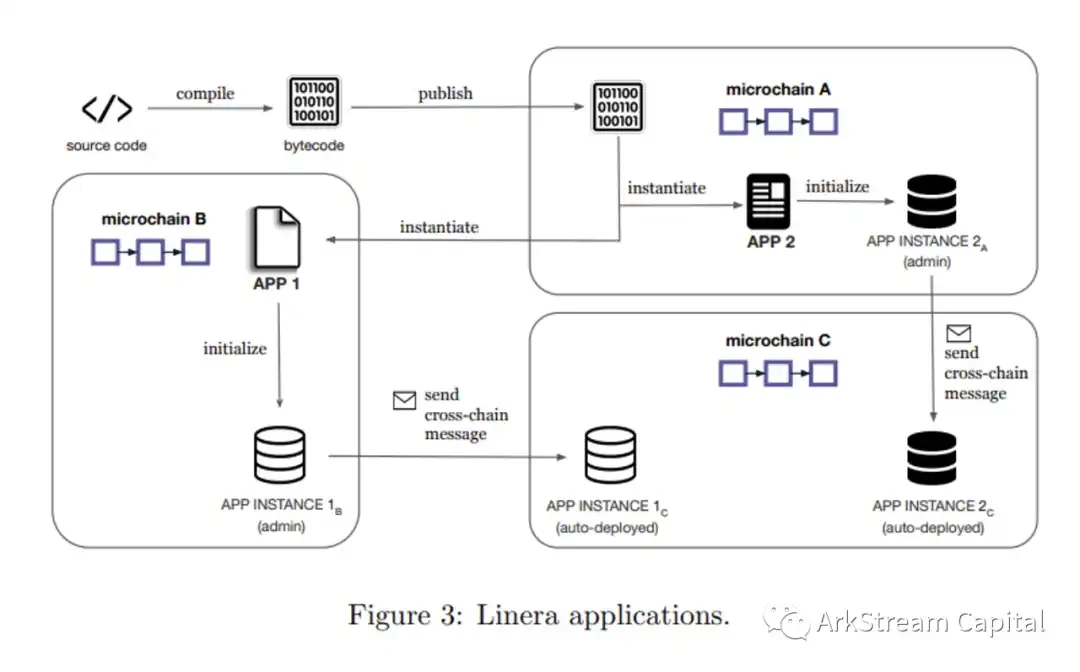
It seems that over the past decade, through its own advantages, cloud-native architecture has gradually occupied the selection of traditional application architectures. This phenomenon of later surpassing and even overtaking makes us believe that investing in Linera is a firm expectation. Based on the mature solutions of Diem/Fastpay and the unique innovative technologies of Linera, there will come a day when Linera can surpass Ethereum in certain application scenarios.
Conclusion
It may be an illusion, but after reviewing these public chains' innovative technologies, it seems that the Rollup As A Service framework prevalent in Ethereum Layer 2 and Cosmos' SDK, as well as Polkadot's Substrate, are quite similar. Even some ideas of the new narrative Restaking are somewhat similar to Polkadot's staking DOT slot auctions and Cosmos 2.0's ICS. The rise of Layer 2 is closely linked to Ethereum's strength, but the exploration of new public chains is equally important, if not more so. The innovation and breakthroughs in the technical exploration and solutions of new public chains will greatly enhance the upper limit of the basic service capabilities of the entire Web3 industry.
As past public chains accumulate more mature experience for the entire industry, it becomes more likely that a more powerful new public chain will emerge in the exploration of innovative public chains. Just as Satoshi Nakamoto was able to creatively propose the decentralized blockchain network of Bitcoin using the proof-of-work mechanism and UTXO model, combined with public-key cryptography, P2P networks, and chained blocks, now and in the future, we have every reason to believe that based on the innovative technologies of the aforementioned new and old public chains, a public chain that combines the strengths of many will emerge in the world of Web3, tasked with achieving Mass Adoption. We can see that innovative public chains, especially those in the Cosmos system (such as Sei Network) and the Diem system/Move language system (such as Linera), will continue to explore the possibilities of blockchain in different dimensions, challenging Ethereum's position and expanding the ceiling of public chains!
Reference
- https://developer.bitcoin.org/reference/
- https://ethereum.org/en/developers/docs/
- https://polkadot.network/development/docs/
- https://docs.substrate.io/
- https://docs.cosmos.network/main
- https://ibc.cosmos.network/
- https://cosmos.network/cometbft/
- https://docs.sei.io/
- https://docs.solana.com/
- https://docs.near.org/
- https://docs.avax.network/
- https://developers.flow.com/
- https://monadlabs.substack.com/
- https://developers.diem.com/docs/welcome-to-diem/
- https://aptos.dev/
- https://docs.sui.io/
- https://linera.io/developers
免责声明:本文章仅代表作者个人观点,不代表本平台的立场和观点。本文章仅供信息分享,不构成对任何人的任何投资建议。用户与作者之间的任何争议,与本平台无关。如网页中刊载的文章或图片涉及侵权,请提供相关的权利证明和身份证明发送邮件到support@aicoin.com,本平台相关工作人员将会进行核查。




